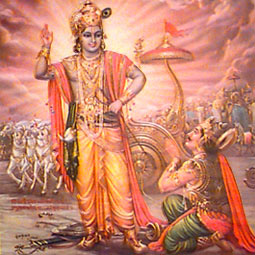Saturday, May 8, 2010
reincarnation according to hindus/indians
Posted by Manju-Ganesh | Saturday, May 8, 2010 | Category:
reincarnation
|
Before we turn to the specific theme of reincarnation in Hinduism, l think it important to specify very briefly what do we intend by Hinduism and Reincarnation in general.
Hinduism
Hinduism is not just a single religion, but a "mosaic of religion", within which we can find most elementary superstitions and mythologies, from the cult of inanimate objects, like stones, rivers, planets to animate objects, like trees, animals, heroes, dead ancestors and spirits; at the same time it presents itself as a fertile field for a most elevated mysticism, which seeks to reach not only the union of the soul with a personal God, the creator and governor of the universe, but even to overcome this dualistic attitude by "realizing" one's identity with the Absolute Spirit. Hinduism, we can say, is the global expression of the religiosity of the peoples of
Hinduism does not have a historical founder, nor does it have a central authority for defining or imposing its beliefs and practices. Hinduism does not insist on many dogmas; regarding God, a Hindu can be believer of monotheism or polytheism or pantheism or monism or even atheism (for example the orthodox Hindu schools of Samkhya and Mimamsa explain everything, including the liberation of the soul without being preoccupied about the existence of God). Hence it is almost impossible to define Hinduism. However we can gather some principles and common practices which go to make Hinduism. They are: (i) faith in the infallible authority of the Vedas (most important sacred scriptures of Hinduism), (ii) faith in the continuous creation, conservation and dissolution of the universe in a cyclic form, (iii) faith in the transmigration of the souls according to the law of eternal retribution (karma-samsara), (iv) faith in the final liberation of the soul from the chains of transmigration (multi, moksha), and (v) the observance of the law of the caste and of the stages of life (varnasrama~harma) 2
Historians divide Hinduism into (i) Vedism, religion based on the first part (stage) of the Vedas, called Samhita (1500-1000 BC), (ii) Brahminism, the second phase of the evolution of the vedic religion, based on the second part of the Vedas, called Brahmana (1000-800 BC), (iii) Upanishad (or Vedantism), the third phase, based on the last part of the Vedas, called Upanishad (800-300 BC); towards the end of this period only did the various philosophical schools of Hinduism arose (the six principal orthodox systems being, Nyaya, Vaiseshika, SamkAya, Yoga, Mimamsa and Vedanta, and the three heterodox being, Buddhism, Jainism and Carvaka), (iv) religious or popular Hinduism (especially the three main religious sects: Vishnuism, Sivaism and Sakitism), which is the religion of the masses, more simple and primitive, notably inspired by the simple and mythological religions of the original inhabitants of India, the Dravidians, and is based mainly on bhakti (loving devotion) which forms the central religious theme of the main smriti (tradition) literature, especially the great epics of Mahabharata (4th century BC to 4th century AD) and Ramayana (4th century BC?), Bhagavat Gita (between the 5th and 2nd century BC), Puranas (considered to be the Veda of the common people), Sutra and Dharmashastra (the code of laws) and (v) neo-lnduisn? (renewed Hinduism after the 19th century) .



